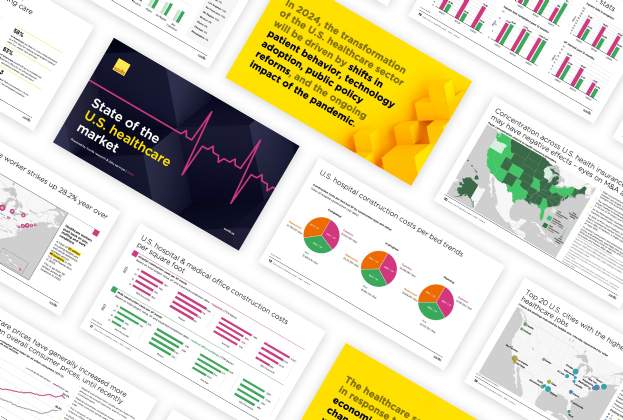Stubborn inflation metrics are slowing the implementation of highly anticipated rate cuts by the Federal Reserve – possibly until late into 2024. Unsurprisingly, this delay in reprieve from high interest costs is detrimental for many in the healthcare sector. According to Moody’s, over 90% of rated health providers have “excess leverage”, and over 50% have weak liquidity inhibiting their business strategies. Healthcare systems that loaded up on debt to pursue M&A-based growth are now seeing that same debt as an albatross around the neck of their balance sheets. Although regulatory issues and media optics have had some influence on the decline of large-scale consolidations, the most significant inhibitor of M&A for healthcare firms is now the dearth of low-rate capital. While many industries were guilty of bingeing on amply available capital sources in the preceding decade, many healthcare systems swelled to unsustainable levels of debt that are no longer affordable nor conducive to near- and long-term business success.
As one example, HCA Healthcare, the largest provider in the country, has accrued debt obligations approaching $40 billion as of December 31, 2023, with a reported $2 billion in annual debt service charges. They are far from unique among providers in carrying hefty loan payments. Moody’s reports that the 40-plus healthcare companies currently rated one level above “junk grade” (BBB/Baa) have almost $80 billion of outstanding debt. Furthermore, each tranche of debt comes with its own covenants, restrictions, and obligations (legal and financial), which can restrict a provider’s ability to respond to market movements.
Adding to the acute stress from provider debt servicing, separate operational stressors include:
- An insoluble nationwide shortage of nurses and other healthcare workers. Savills 2024 State of the U.S. Healthcare Market Report highlights this quandary and shows talent abandoning industry jobs at a faster rate than before the pandemic.
- Forecasted demand for still more nurses will continue to far outpace supply in the next decade. This is anticipated to steadily drive wages/costs higher for providers while potentially compromising outcomes due to shortages.
- Further compounding the issue, the number of healthcare worker strikes was up 28.2% year over year in 2023.
- Other factors include a decline in primary care utilization, an increase in regulatory scrutiny, and a weakening medical subsidy pipeline that threatens chronically thin margins as systems are exposed to increased oversight and reduced reimbursements.
The likely end-result of this partial list of challenges is elusive revenue growth and shrinking margins for even the best-managed systems. Unfortunately, to address most of these issues, continued capital investment is required, creating a catch-22 for already indebted providers.
Access to capital will be essential to service accumulated debts, upgrade functionally obsolete or underutilized facilities, and purchase opportunistic provider groups. Simply put, healthcare systems face a pressing need today to cut costs and “discover” sources of capital at tolerable rates. One strategy includes a focus on creative solutions to monetize real estate assets, optimizing cash and right-of-use expenses while retaining long-term control in exchange for liquidity today.
This quest for liquidity has led to large-scale initiatives by multiple large systems to mine their expansive real estate portfolios for creative structuring opportunities.
A multi-phased portfolio rationalization can often yield significant funds when traditional sources are frozen, absent, or prohibitively expensive. Determining strategic, non-core, and commodity assets in the portfolio will provide a host of asset monetization strategies that can be tailored around the needs of the system by the right advisors. A project of this magnitude is nuanced and will ideally involve executives across the system to align on business strategy, facilities management, and capital allocation. However, the result can often yield increased utilization and efficiency, provide a capital windfall, and position the system for long-term flexibility and control of its assets. Even leased properties traditionally viewed only as fiscal “liabilities” become assets for monetization when structured properly with the right capital partners. It is common for systems to unlock tens or hundreds of millions in liquid capital by pursuing facility monetization strategies that do not cede long-term control or ownership of the assets themselves.
As we progress through 2024 and beyond, we anticipate seeing proactive healthcare systems continue to explore this new pool of opportunities to leverage their oft-overlooked real estate.
.jpg)

.jpg)